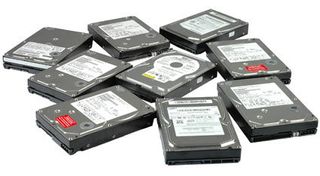2007 HDD Rundown: Can High Capacities Meet High Performance?
More To Store: 10 New Hard Drives Compared

It is estimated that a majority of desktop computers in the US use hard drives with capacities between 30 and 100 GB. While this might be sufficient for office use, your gigabytes will be eaten up quickly if you start working with photos, video and audio That's why modern multimedia computers are equipped with larger 250 to 400 GB hard drives. Is it time for you to consider a hard drive upgrade?
The answer to that question should only be "absolutely yes" for computers that are actually being used regularly, since additional storage is only one of multiple advantages. Data density has increased steadily from generation to generation, which is the main reason why a 160 GB drive needed two or three platters only a few years ago, while the same capacity point can be realized with only a single platter today. The advantages are obvious: the drive consumes less energy, operates at lower noise and also dissipates less heat, all very beneficial for hard drive durability.
In terms of performance the new models excel, as increased storage density and progressive recording techniques open the door to higher data transfer rates. Recently, we conducted an extensive review and compared today's fastest and largest hard drives with 15 year old devices . We came to the conclusion that the hard drive is still every system's main bottleneck, since users must wait in "time out" while Windows and applications launch. Faster drives are simply a blessing for every ambitious user.
But you don't have to spend a lot of money to get high hard drive performance. It is also wrong to assume that larger capacity drives are faster, in general. Hitachi offers its DeskStar T7K500 not only with 500 GB, but also as a 160 GB version. Seagate's Barracuda 7200.10 comes in capacities ranging from 80 to 750 GB. These drives provide you with the latest recording technologies, and thus maximum performance, without spending tons of money for high capacities you might not need.
We divided our test candidates into three categories:
System HDDs
The main priority here is high performance. You might consider these models if you are looking for a drive to hold your Windows installation and temporary files.
All-around Drives
Are you looking for a drive of medium capacity at an attractive price? This is the category where you will find your product. We consider this category the so-called "sweet spot" of the hard drive market in early 2007.
Stay On the Cutting Edge: Get the Tom's Hardware Newsletter
Join the experts who read Tom's Hardware for the inside track on enthusiast PC tech news — and have for over 25 years. We'll send breaking news and in-depth reviews of CPUs, GPUs, AI, maker hardware and more straight to your inbox.
Storage Giants
The more storage, the merrier!
Hard Drives for Upgrades
While all options depicted above are equipped with a Serial ATA interface, computers that are two years or older are usually not endowed with that interface. Therefore, you will need a model with UltraATA interface.
Current page: More To Store: 10 New Hard Drives Compared
Next Page Meet The Devourers: Music, Photos, Videos, And GamesMost Popular



